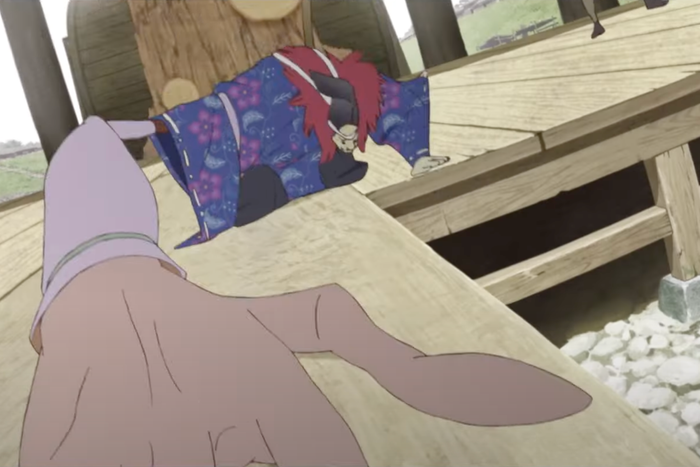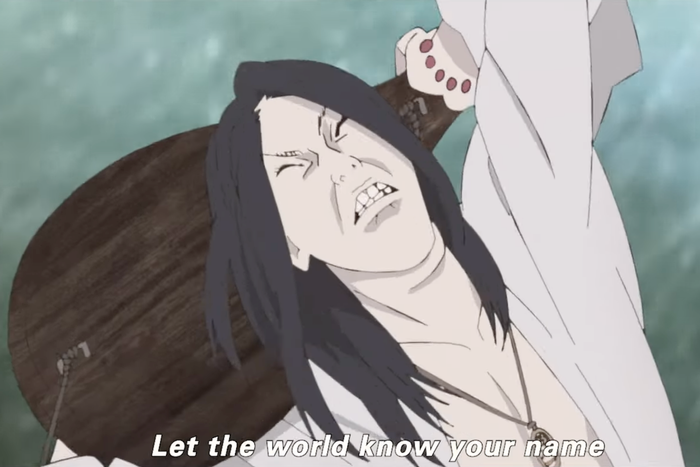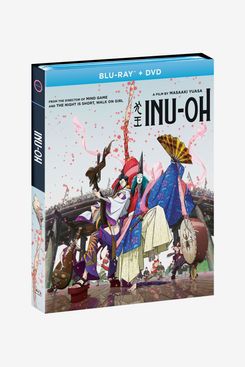There’s an animated rock concert early in Inu-Oh, the latest film from Masaaki Yuasa, that opens with a long-haired blind man standing on a bridge, dressed in traditional Japanese garb and shredding on his biwa lute. As he twirls through the crowd, playing and singing, a banner drops from the bridge and onto the dry riverbed below. It displays the name 犬王 (“Inu-Oh”) in dramatic kanji lettering that introduces his partner: a contorted, dancing man in a demon mask who leaps high into the air from beneath a wooden stage set up along the riverbed. Upon landing, he gyrates his hips, swings his body around, and sings a story about having been born different: His eyes and mouth swapped places at birth, and his supernaturally long right arm extends to more than three times the length of his left. Separately, the two men are adrift and broken, but together, they’re mesmerizing.
This is the unlikely duo’s first major performance together in Inu-Oh, a blend of anime concert film and historical epic that infuses traditional Noh theater with a rock-and-roll energy that keeps ramping up. After its Japanese debut in May, the movie saw a limited theatrical run in North America in August but went largely unnoticed outside anime and art-house circles until it received a Golden Globe nomination last week, an uncommon distinction for an anime film. Now that Inu-Oh is getting its North American home release (arriving on digital platforms today and Blu-ray in January), more viewers can finally see what makes it such a spectacle. Between the exaggerated, anachronistic character animations and the manner in which the extravagant set pieces are edited together, Inu-Oh feels unlike anything you’ve seen onscreen — unless you’ve watched a Yuasa movie before.
Many of the mainstream anime movies from the past decade have a few traits in common: sweeping romance, a high school–age protagonist, Studio Ghibli–inspired depictions of nature, and references to cultural practices rooted in Shintoism and Japanese history. And, sure enough, the plot of Inu-Oh isn’t unusual for an anime: Tomona, the blind musician, and Inu-Oh, the masked dancer, find success and navigate adversity as they perform songs that inspire the masses and frustrate the powerful establishment in 14th-century Japan. Few other national cinemas are connected so singularly to a specific location as anime despite it now being a global art form.
But animation has often, as with all cinema, crossed international lines for inspiration. Since popular shows like Sailor Moon and Neon Genesis Evangelion and ambitious films such as Akira and Princess Mononoke broke through to the West in the late 20th century — preceded by ‘60s classics like Astro Boy and Speed Racer, which gained smaller pockets of global viewership — anime has become a huge influence on American animation. Critically lauded American TV shows such as Avatar: The Last Airbender and Steven Universe owe much to their creators’ childhood love of Japanese animation, with the latter containing numerous subtle and not-so-subtle references to the sword-wielding hero of Revolutionary Girl Utena. Even films as popular and mainstream as Pixar’s reference anime regularly; one of the tongue-in-cheek potential titles for Turning Red was My Neighbor Toronto.
At the same time, creators of Japanese animation have always been gazing back at the West. Yuasa, one of the freshest and most popular voices working in anime, borrows from endless pockets of animation history to craft a style entirely his own. Rather than drawing only from the incredible anime directors who preceded him, Yuasa has explicitly invoked a diverse array of works while refining his style. His 2004 film, Mind Game, used a patchwork mix of CGI, sketchy 2-D, and other unusual techniques to relay action — a lot like how animator George Dunning wove colorful, surreal environments to accompany the Beatles’ music for Yellow Submarine. Dance sequences are a Yuasa favorite, too, whether they’re lively and active or carefully deliberate. A memorable sequence in his 2017 film Night is Short, Walk on Girl stages characters spontaneously bursting into an elaborate, slow-walking dance. Their movements are playfully unsettling, calling to mind the stop-motion creations of Russian animator Ladislas Starevich, who attached wires to insect limbs in the early 20th century to create his exacting, bug-filled animated films.
Yuasa’s clearest influence is early American animation and the snarky, distinctive styles of Tex Avery and the Fleischer brothers. He directly takes elements of their visual approach, using bizarre transformations and exaggeration to make his set pieces pop in sequences like the oddly intense table-tennis matches in Ping Pong: The Animation and the kinky wrestling scenes in Kick-Heart. His work calls back to Avery’s Red Hot Riding Hood and its Wolf, who could explosively morph his body and relentlessly hammer his head in lust. It also pulls from the surrealism of the Fleischer brothers’ classic Out of the Inkwell cartoons, which regularly played with the scale and dimensions of their characters, even placing them on top of live-action environments, an early demonstration of the innovation and plasticity the medium can convey. In some ways, this is history repeating itself — Astro Boy creator and “Godfather of Manga” Osamu Tezuka famously admired Walt Disney’s visual style and ethos, and many of Studio Ghibli’s films pull from European texts — but the specific vibrance and infectious energy Yuasa brings into the mix, with his playful cultural hybridity, is undeniably fresh.
You can see some hints of Yuasa’s style as we now know it in his early television contributions The Hakkenden and Crayon Shin-chan, but Mind Game, his feature debut, pinpointed his trademark oddness. Moving at a mile a minute, the film feels like a visual representation of improvised jazz, switching tone and style so quickly that you can barely process it but deftly enough that it feels cohesive. In one scene, characters groove to an unpredictable piano piece — first underwater as they ride on sea monsters, then on an endless dance floor as they move to the rhythm as precisely as the dots bounce in Scottish Canadian animator Norman McLaren’s experimental piece “Dots.” The frame splits once, then twice, as the scene reaches a climax, its characters’ faces brimming with energy mere inches away from the make-believe camera as it twirls up, down, and around their contorting bodies. This chaos echoes the psychedelic animations of the 1970s like Pink Floyd’s The Wall and even has a hint of older Dr. Seuss cartoons like Halloween Is Grinch Night. But the film never strays far from its anime roots, frequently using visual standbys such as characters frozen in horror or vibrating through a backdrop to signify manic movement.
If there’s one animated sequence that fully captures the exuberance Yuasa brings to his work, it’s the dance sequence in his 2017 feature film Lu Over the Wall. Focusing on a misanthropic teenager whose enthusiasm for life is reenergized by his ningyo (a sort of Japanese mermaid creature) friend, Lu, and her love of music, the film reaches its peak in a scene on the beach in which Lu’s rhythm is so contagious that every resident of the town is compelled to dance the day away. By shifting the “camera” from the static faces of the characters to the exaggerated wiggles of their feet, Yuasa bends the rules of how anime is supposed to look before breaking entirely from them with sequences that feel as if they were ripped straight from experimental, noodle-y, rotoscoped 1930s Fleischer cartoons like Minnie the Moocher. Bodies grow and shrink to the beat at the whim of the director, some even compelled to break into the “Thriller” dance, and when Lu breaks it down with a huge, childish grin on her face, it’s hard not to watch and grin back.
Yuasa’s performance sequences in Inu-Oh are some of the purest distillations yet of that buoyant, masterful filmmaking. Tomona wields his lute like Hendrix, playing behind his head and sending the crowd wild, while Inu-Oh waves his extended right arm around, his proportions reminiscent of a reversed version of R. Crumb’s “Keep on Truckin’” characters. The duo’s rise to fame mirrors Yuasa’s own, from becoming an art house–animation favorite in the early aughts to reaching the eyes of Netflix executives in the late 2010s and finding continued critical praise for Inu-Oh. Their masterful playing and unorthodox dancing work as effectively in tandem as Yuasa’s seemingly disparate artistic references, combining national tradition with transnational creativity just as the director’s own globally inspired cinematic collages do.
Out today on digital platforms. Available for preorder on Blu-ray and DVD (out January 23).




